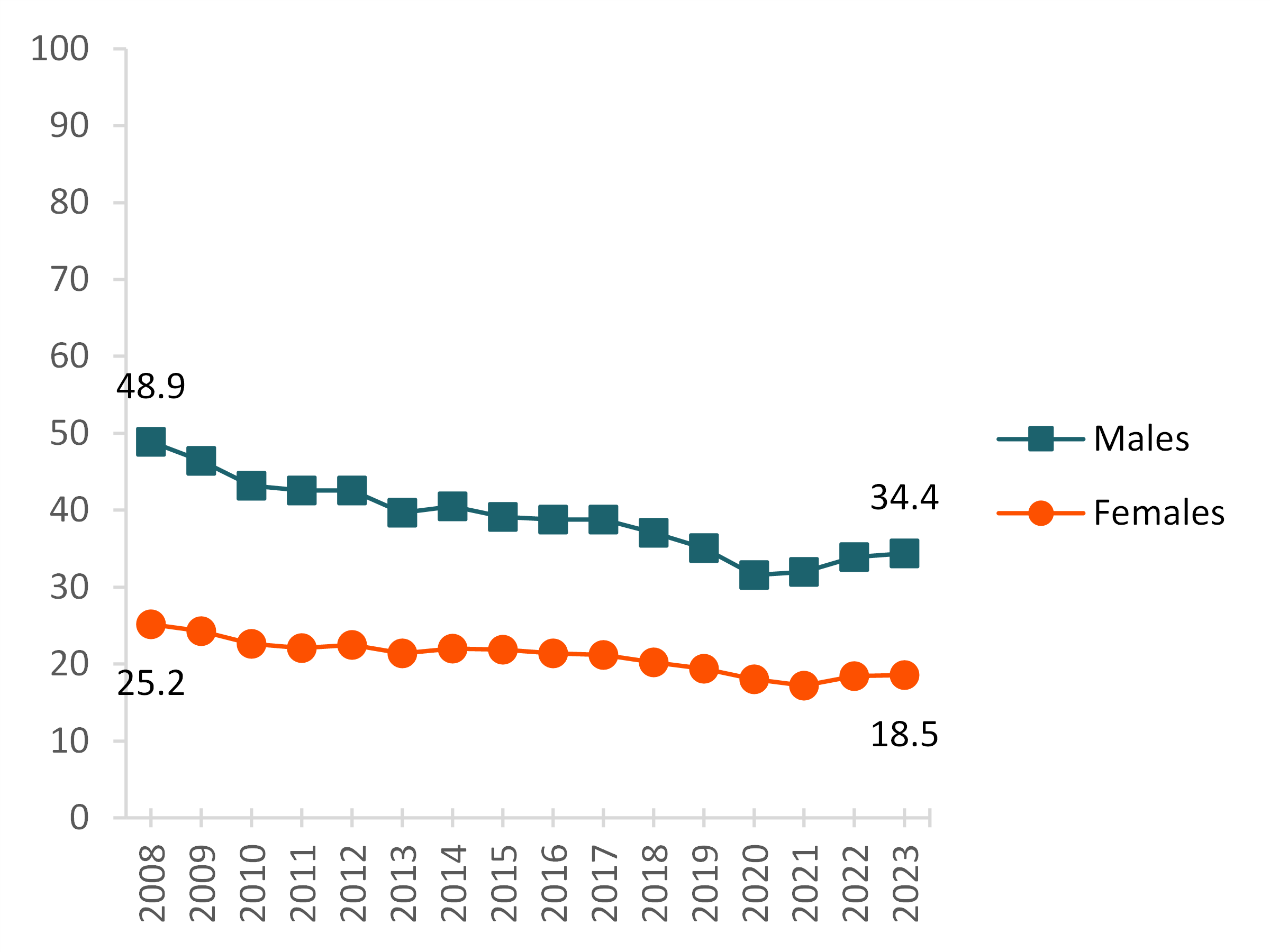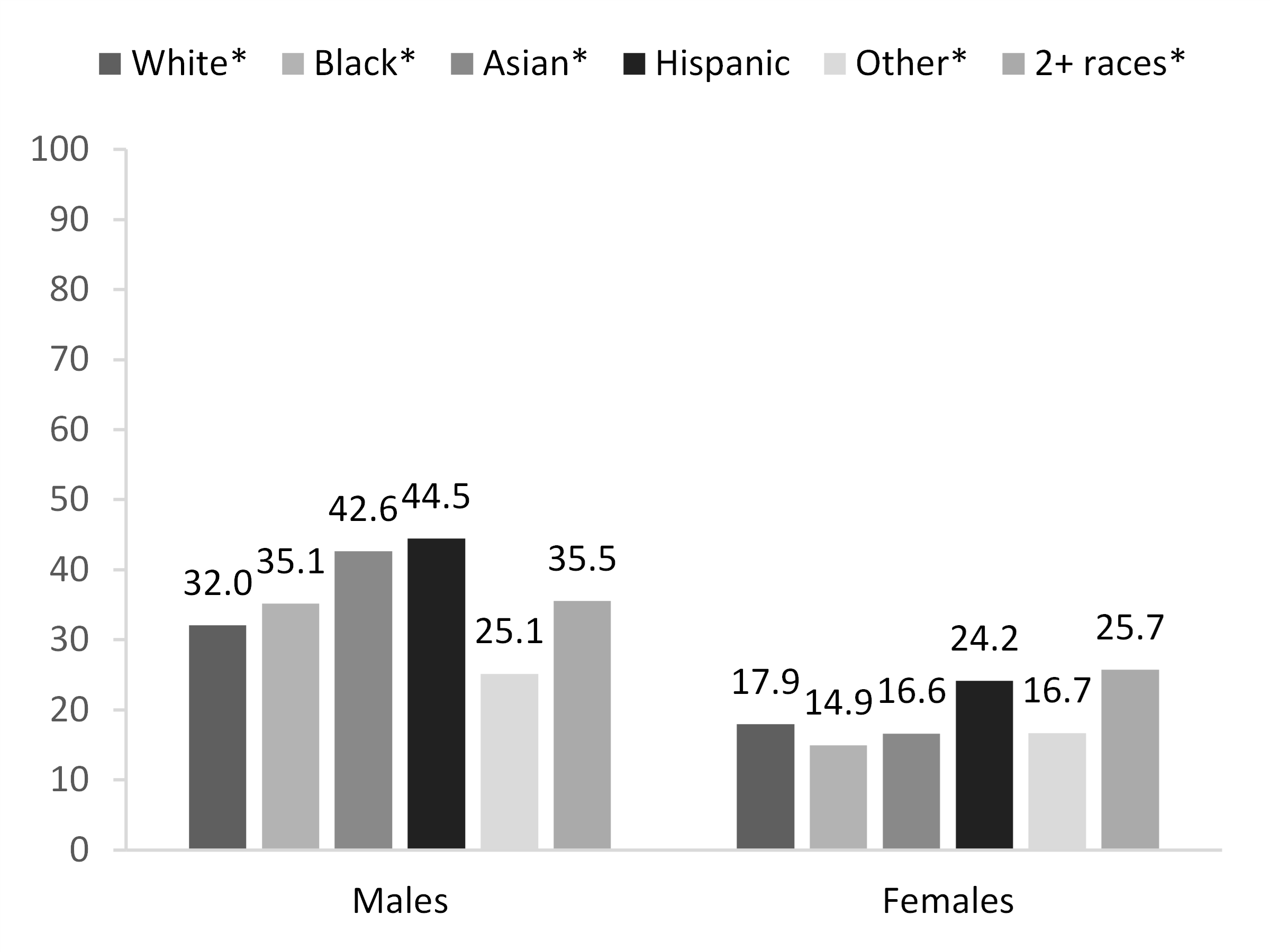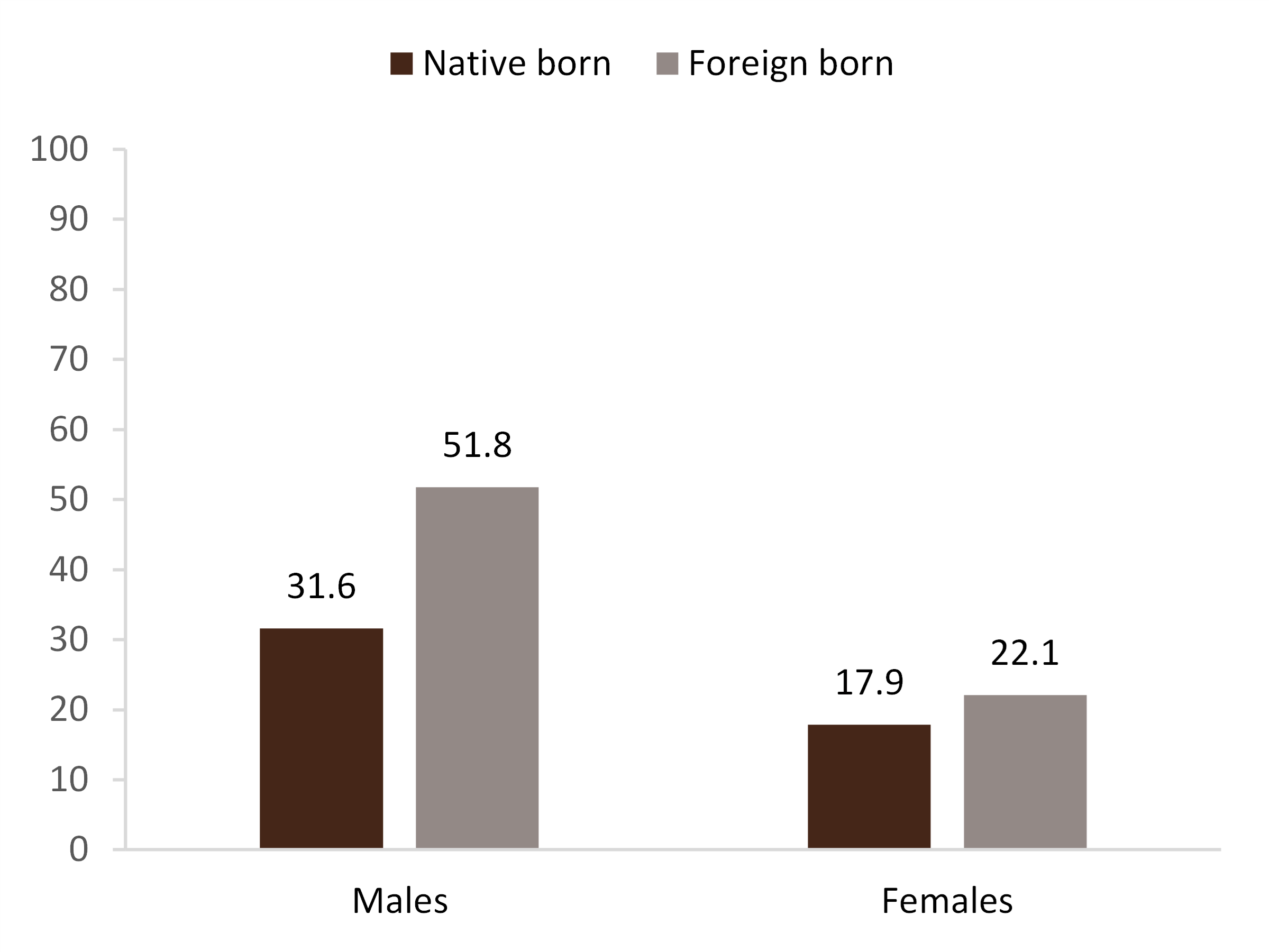Remarriage Rate, 2023
Family Profile No. 3, 2025
Author: Natalie Bankey
Refined marriage rates in the U.S. have seen a 54% decrease since the 1990’s, with only 31.3 per 1,000 unmarried women married in 2022 (Loo, 2024). The refined divorce rate increased steadily throughout much of the 20th century until it peaked around 1980 and since then has been slowly declining (Loo, 2024). At the same time, recent decades have been marked by a substantial decrease in remarriages, with only 24.1 per 1,000 previously married U.S. adults entering remarriage in 2022 (Loo, 2024). This Family Profile provides an update of remarriage rate estimates for males and females aged 18 and older in 2023 using the latest release of the U.S. Census Bureau’s American Community Survey (ACS) provided by IPUMS-USA. This profile is an update to previous profiles on the remarriage rate (FP-15-08; FP-18-16; FP-19-17; FP-21-18; & FP-23-19).
Trends in the Remarriage Rate for Males and Females
- Since 2008, the remarriage rate has generally declined for both males and females. Among previously married males, the rate fell from 48.9 to 34.4 remarriages per 1,000, whereas for previously married females, it dropped from 25.2 to 18.5 remarriages per 1,000 in 2023 (see Figure 1).
- An estimated 556,951 males and 532,504 females experienced a remarriage in 2023 (not shown).
Remarriage Rate by age for Males and Females
- Generally, remarriage rates decreased with age (see Figure 2).
- The highest remarriage rates were among females aged 18-29, with 100.4 per 1,000 previously married entering a remarriage. The highest remarriage rate among males was experienced among those aged 30-44, with 73.2 per 1,000 previously married males entering a remarriage.
- The lowest remarriage rate was among those aged 75 and older (7.9 and 1.5 remarriages per 1,000 previously married).
- The remarriage rate showed a gender gap that widened with age. Across all age groups, men had higher remarriage rates than women becoming more pronounced among older individuals.
Figure 1. Remarriage Rate for Males and Females, 2008-2023

Figure 2. Remarriage Rate for Males and Females 18 and Older by Age, 2023

Remarriage Rate by Race, Ethnicity, and Nativity for Males and Females
- Both Hispanic males and females experienced the highest remarriage rates (44.5 and 24.2 remarriages per 1,000 previously married, respectively) (see Figure 3).
- Racial or Ethnic “Other” males had the lowest remarriage rates with 25.1 remarriages per 1,000 previously married. Among females, Black women had the lowest remarriage rates with only 14.9 remarriages per 1,000 previously married (see Figure 3).
- Overall, males had higher remarriage rates then their same racial/ethnic female counterparts (see Figure 3).
- Remarriage rates were higher among those who were foreign-born, with a greater variation by nativity among males than females (see Figure 4).
Figure 3. Remarriage Rate for Males and Females 18 and Older by Race and Ethnicity, 2023

Figure 4. Remarriage Rate for Males and Females 18 and Older by Nativity, 2023

Remarriage Rate by Educational Attainment for Males and Females
- Both males and females showed similar patterns of remarriage by educational attainment, with rates being higher among males at each educational attainment category.
- Remarriage rates were lowest among those with the lowest educational attainment (less than a high school diploma/GED); 25.6 remarriages per 1,000 previously married males and 10.6 remarriages per 1,000 previously married females.
- The highest remarriage rates were among those with the highest educational attainment (a master’s degree or higher) for males and females alike (47.0 and 24.6 remarriages per 1,000 previously married, respectively).
Figure 5. Remarriage Rate for Males and Females 18 and Older by Educational Attainment, 2023

Data Source:
Flood, S., King, M., Rodgers, R., Ruggles, S., Warren, J. R., Warren, D., Chen, A., Cooper, G., Richards, S., Schouweiler, M., & Westberry, M. (2024). IPUMS USA: Version 15.0. Minneapolis, MN: IPUMS. https://doi.org/10.18128/D010.V15.0
References:
Loo, J. (2024). Divorce: More than a Century of Change, 1900 & 2022. Family Profiles, FP-24-11. Bowling Green, OH: National Center for Family & Marriage Research. https://doi.org/10.25035/ncfmr/fp-24-11
Loo, J. (2024). Marriage: More than a Century of Change, 1900 & 2022. Family Profiles, FP-24-10. Bowling Green, OH: National Center for Family & Marriage Research. https://doi.org/10.25035/ncfmr/fp-24-10
Loo, J. (2024). Age Variation in the Remarriage Rate, 1990 & 2022. Family Profiles, FP-24-09. Bowling Green, OH: National Center for Family & Marriage Research. https://doi.org/10.25035/ncfmr/fp-24-09
Payne, K. K. (2015). Remarriage Rate: Geographic Variation, 2013. Family Profiles, FP-15-08. Bowling Green, OH: National Center for Family & Marriage Research. https://www.bgsu.edu/ncfmr/resources/data/family-profiles/payne-remarriage-rate-fp-15-08.html
Payne, K. K. (2018). Change in the U.S. Remarriage Rate, 2008 & 2016. Family Profiles, FP-18-16. Bowling Green, OH: National Center for Family & Marriage Research. https://doi.org/10.25035/ncfmr/fp-18-16
Reynolds, L. (2021). The U.S. Remarriage Rate, 2019: Trends and Geographic Variation by Gender. Family Profiles, FP-21-18. Bowling Green, OH: National Center for Family & Marriage Research. https://doi.org/10.25035/ncfmr/fp-21-18
Schweizer, V. (2019). The Retreat from Remarriage, 1950-2017. Family Profiles, FP-19-17. Bowling Green, OH: National Center for Family & Marriage Research. https://doi.org/10.25035/ncfmr/fp-19-17
Westrick-Payne, K. K. (2023). Remarriage Rate, 2021. Family Profiles, FP-23-19. Bowling Green, OH: National Center for Family & Marriage Research. https://doi.org/10.25035/ncfmr/fp-23-19
Suggested Citation:
Bankey, N. (2025). Remarriage Rate, 2023. Family Profiles, FP-25-03. Bowling Green, OH: National Center for Family & Marriage Research. https://doi.org/10.25035/ncfmr/fp-25-03
This project is supported with assistance from Bowling Green State University. From 2007 to 2013, support was also provided by the U.S. Department of Health and Human Services, Office of the Assistant Secretary for Planning and Evaluation. The opinions and conclusions expressed herein are solely those of the author(s) and should not be construed as representing the opinions or policy of any agency of the state or federal government.
Updated: 01/27/2025 03:29PM

